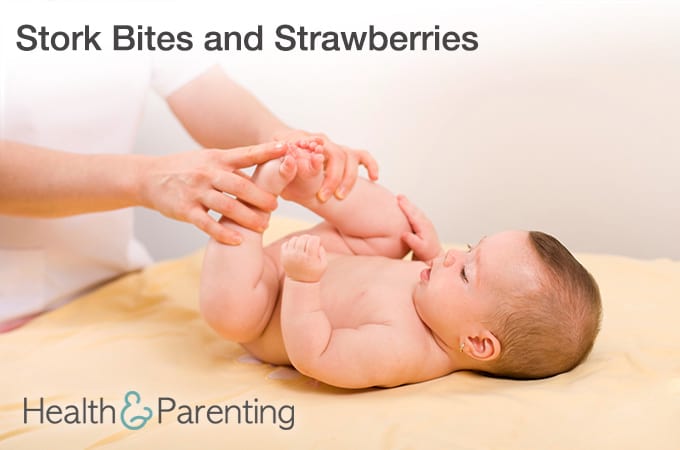Nevus simplex and capillary hemangioma: these are the official medical terms for those birth marks that are more commonly referred to as stork bites and strawberries respectively.
Both marks are temporary, usually going away by the time a child reaches five years of age. Stork bites are seen in about a third of all newborns and are caused by the stretching of certain blood vessels. They are usually pink and flat and might also be called a salmon patch. What’s interesting about stork bites is that they won’t necessarily appear right at birth; sometimes they don’t become apparent until a few months of age. You will usually find them on the forehead, eyelids, nose, upper lip, or the back of the neck.
Strawberries, on the other hand, are often raised, red marks that are typically present at birth on the chest, upper back, or head. Approximately 10 percent of babies are born with strawberries, and they can be as small as a freckle or as large as a grapefruit. The marks themselves are soft and are the result of extra blood vessels that broke away in development.
In most cases, no treatment is prescribed for either stork bites or strawberries. Instead, your pediatrician will likely recommend a wait and see approach. If a strawberry starts to grow or bleed, treatment may become necessary, to include steroids, surgery, or laser therapy, but in most cases, both marks will begin to fade on their own with time.
Still, when these marks are especially large, it can be hard to face the questions of others when it comes to your baby’s physical features. In January of 2016, mom Katie Crenshaw wrote about the reactions of strangers to her daughter’s strawberry mark. The blog post went viral as a result of its blatant honesty and tips for what to say to a parent whose child has one of these marks. You may find some comfort in reading her words and decide you want to share the post yourself.
Either way, know that your child’s birthmark is just a part of who he or she is, and that with time, it will fade. In most cases, stork marks and strawberries pose no health risks, and therefore require no reason to be concerned or seek further treatment. Your baby isn’t hurting as a result of this mark, and is just basking in your love like all other babies his or her age. So enjoy those smiles; they were meant just for you!
Written by Leah Campbell, infertility advocate, adoptive mama, writer and editor. Find me @sifinalaska on Twitter.
This information is not intended to replace the advice of a trained medical doctor. Health & Parenting Ltd disclaims any liability for the decisions you make based on this information, which is provided to you on a general informational basis only and not as a substitute for personalized medical advice. All contents copyright Health & Parenting Ltd 2016. All rights reserved.










